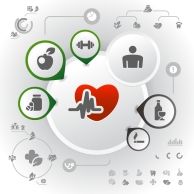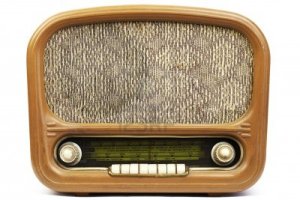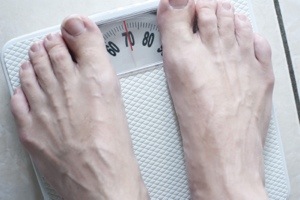Tips
What your gym gear says about you [video - NSFW]
Gloves, wraps, altitude masks, caps… what you wear in the gym can say a lot about you. But you might not like what you hear! Read the rest of this entry »
Goal setting
Training without a goal is like driving without a destination. Sure, it can be fun but it’s ultimately futile. Goals can take all sorts of different forms. Read the rest of this entry »
New Years Resolutions vs Real Goal Setting
It’s late January and by now a significant number of people who set New Years Resolutions are already giving up. Have you set some fitness goals for 2014? How can you achieve them? What’s the secret of successful goal setting? Read the rest of this entry »
Big Data and Exercise

Anyone who follows business technology will no doubt be familiar with the buzzword “big data”. It represents the recent shift towards large volumes of data that are delivered faster than ever before from many different sources. Well, big data isn’t just a business problem – it’s infiltrating our daily lives in a personal way. Big data has become a part of how we know exercise and manage our health.
Exercise technology and apps
 Last week, on my semi-regular radio spot on 774 Local Radio, the host Raf Epstein and I chatted about apps and devices that can help you with your fitness goals. Read the rest of this entry »
Last week, on my semi-regular radio spot on 774 Local Radio, the host Raf Epstein and I chatted about apps and devices that can help you with your fitness goals. Read the rest of this entry »
What’s a reasonable rate of weight loss?
Most people, when they start an exercise and diet program, focus on one number – their weight. Standing on the scale each day, or even more often, becomes an obsession. Every kilogram or pound that comes off is a victory and any increase can be very discouraging.
 One thing to remember is that your weight can fluctuate each day by a kilogram or so (I’m staying metric – 1kg = 2.2lb) because of hydration or recent meals that haven’t made their way through your digestive tract. Also, you’ll find that your weight changes through the course of the day and even if you move your scales. I can gain and lose weight simply by moving my scales from one part of the bathroom floor to another.
One thing to remember is that your weight can fluctuate each day by a kilogram or so (I’m staying metric – 1kg = 2.2lb) because of hydration or recent meals that haven’t made their way through your digestive tract. Also, you’ll find that your weight changes through the course of the day and even if you move your scales. I can gain and lose weight simply by moving my scales from one part of the bathroom floor to another.
There’s no hard and fast rule as to the best rate of weight loss. In my case, the first few kilograms came off quite quickly but things then slowed down to 0.5kg or less per week. There have been weeks when the weight loss stopped but it then resumed.
It’s not just weight you should track
As well as tracking your weight I’d suggest doing a couple of other things.
1. Take regular measurements: Using a a tape measure, record your chest, waist, hips, thigh, calf and arm measurements. Once you’re exercising you’ll find that your body will change faster than the scales. Although you’ll become leaner, and consequently your measurements will shrink, your weight might not follow suit.
2. Don’t worry about daily fluctuations: Your weight will fluctuate each day – that’s a fact of life. Pay more attention to the trend rather than any one reading.
There are several other measures such as BMI that people use as a measure of their body fat. However, that measure isn’t of much use for people that exercise. As your muscle mass increases your weight will increase as muscle is heavier than fat. As a result, it’s possible to be quite lean but have a high BMI.
My doctor focuses on just one measure – waist size. There are strong correlations between waist measurement and health issues such as heart disease.
Whatever you choose, remember that your weight is just one dimension of your health. It’s one indicator amongst many of the progress of your exercise program.
What’s your motivation?
Everyone who exercises does it for some good reason. Usually, you hear things like “to lose weight”, “get fitter for ” or “look better”. My suspicion is that the real reasons are often a little deeper.
My story
Until about eight years ago I exercised regularly. I ran, getting up to a half-marathon, played squash and lifted weights. My weight was under control and I was pretty fit. But I slacked off – that started with injury but was fueled by laziness – and in January this year my weight peaked.
I’m now 45 years old. When my father was 45, he was overweight and had been diagnosed with Type 2 diabetes. I could see that I was on the same path as I inherited his body shape. So, it would seem that I have a constant battle with Mother Nature to fight.
The real motivation
My father died a few years ago. The last decade of his life was spent in and out of hospitals. There was a heart attack followed by strokes, open heart surgery and numerous other complications. While he was still in complete possession of his cognitive abilities the physical challenges were significant.
Many of these issues were avoidable. The diabetes was lifestyle driven and it was this avoidable disease that drove the complications that ultimately took my father’s life.
I have three children. I like being able to swim with them, hassle them on a basketball court, play tennis and chase them around the park. Unless I stay healthy I can’t do that with them and, hopefully when the time comes, their children.
For me, the real motivation isn’t about being thinner or running faster or further. Those things are just markers along a far more important road of lifelong health and fitness so that I can enjoy life.
What really motivates you?
Dealing With Injury
Today marks exactly three months and one day since I started exercising regularly. According to Nike+ I’ve covered 189km in 40 runs over about 22.5 hours. Throw in a few weight training sessions and its been a productive time. I’ve dropped two sizes, lost over 14 kg (30 lbs) and feel far healthier, stronger and fitter. And today marks my first injury.

It seems that I’ve strained my left calf while running this morning. I wasn’t pushing hard – I always go easier when increasing my distance – and was coming off a rest day. The surface was stable. As far as I can tell, there was no reason other than I’m not a kid anymore.
What did I do first?
Once I got home, I made up an ice pack, put my leg up and started to try to reduce the inflammation and pain. As I’m on holidays, and was planning to head out, I spent some time standing in the water at the beach. A couple of sessions in the water and some very gentle stretching eased some of the pain and stiffness.
At this stage, while I’m still sore and limited in movement, I’m not too worried as this is my body’s way of protecting me from further damage. Soft tissue injuries go through several stages of recovery before being finally resolved.
If this is a minor strain I suspect I’ll be back to some light running in a week or so. I suspect that the worst case is a three week break from running.
What’s next?
I’m not sure how severe the strain is yet but I’m guessing I’ll be off running for at least a week. One piece of advice about recovering from running injuries suggests engaging in some cross-training and easing back into running with some run/walk sessions. I’m thinking of repeating week one of Couch to 5K.
I’ll be back in weight room in a day or so but will focus on upper body exercises and lay off the squats and deadlifts. I might think about the exercise bike if the pain subsides but not before.
If the pain is still there in a week, I’ll see a doctor and look at other recovery options.
I’m not diving straight into over the counter anti-inflammatory medications like ibuprofen. While they may be effective, there are plenty of contra-indications (list of potential ibuprofen side effects) and I’ve always preferred to let my body heal itself, resorting to medications only after giving my body a chance.
Goal Setting
How do you set fitness goals? Do you start with weight loss? Is it about strength or endurance? What’s the best way?
To be honest, I haven’t a clue. If I had the answer, I’d write a book, get a TV show and get rich. All I know is what has worked for me in the past, what is working for me now and that without a destination in mind, there’s no way to map a journey.
The trick to goal setting is to set lots of milestones that are achievable and work towards the longer-term goal. For example, lets say you want to lose 22kg (or about 50lbs) that’s a very difficult thing to get your head around. But setting a goal to lose 2kg per month is achievable.
The same goes with running or some other aerobic activity. Being able to run for 30 minutes could be daunting but running for a minute might be more realistic if you’re coming from a base of inactivity.
When I set my goals, back at the start of this year, I combined the two. I had a combination of weight loss and endurance goals. My running goal was to complete a Couch to 5k program in the allotted time. However, I was focussed on running for 30 minutes rather than 5km. The 30 minute 5km prize still eludes me.
For weight loss, I set myself a long term goal to reach my target “one day”. The only target is to be a little lighter at the start of each week. There’s no self-imposed pressure to hit a target – as long as there’s progress I’m not too worried about the pace.
Back about a decade ago, when I was quite fit, I set two goals; a target weight and to run a half-marathon. The trouble was that when I hit them, my training completely lost momentum. My goals are now about long-term activity and lifestyle.
How do you set goals?

